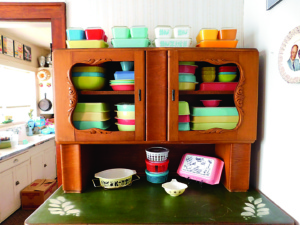By SAVANNAH TILLMAN, Feature Editor

Collection of Pyrex glassware moves to Alva, Okla.
Mickey Jordan, Senior Theater major at Northwestern, has been collecting Pyrex glassware for the last seven years. “My friend Michael Blackford, graduate of Pittsburg State, first got me hooked on the history of Pyrex several years ago,” Jordan said. “Blackford’s collection has grown to roughly 500 pieces.”
Jordan was featured in Northwestern News last spring, in the January 21, 2016 addition for his love of nostalgic 50’s and 60’s décor. “Mayberry” as Jordan calls Alva, Okla., hasn’t always been home to his ever growing Pyrex collection; but due to unforthcoming events, he had to relocate the collection to Oklahoma.
In recent years, more and more individuals are looking to find and collect the iconic glassware. “It takes time and money to gather all the sets. I want to make sure I have each color of each set and as time progresses it is becoming harder to find it all,” Jordan said. “People back then never would have known their glassware would be worth so much today. Lots of times they would place the items in the dishwasher and after a couple times that shiny, glossy coating would come right off.”
Walking into Jordan’s kitchen, Pyrex ads fill the walls and display a sense of a time not so very long ago. Each one presents a different promotion, for a different set, that was available for purchase. Jordan has almost every promotion, from those ads, setting in his dining room hutch and on his table. “I collect items, such as this because good design is good design. Things were made to last back then and the quality is far greater then, than it is now,” Jordan said.
Pyrex, originally produced by the Corning Glass Works, celebrated its 100th Anniversary in 2015. The company was known for creating temperature-resistant borosilicate glass for railroad lantern globes. “Bessie Littleton, wife of Jesse T. Littleton, a Corning scientist, baked a cake in a sawed off Nonex battery jar. Her discovery was that the cake did not stick to the jar and it allowed it to cook evenly and efficiently,” according to Corning Museum of Glass. This discovery launched an idea for bake ware and in 1915 the first production of Pyrex glassware was sold.
With the variety of options, the possibilities are endless. When Pyrex originally started the glassware was clear and it wasn’t until 1936, when the promos for the colors started: yellow, red, green and blue. As time progressed, the sets progressed. Bowls, oven ware, stove-top ware, etc. became available for every family. The 40’s-60’s produced some of the most iconic Pyrex sets, like Desert Dawn, Balloons, Mod Kitchen and Black Roosters.
Also throughout the last century, the cost and quality of the Pyrex has fluctuated. During the depression, Pyrex made the Blue Delphite or also known as Bluebelle, which were untimely cheaper to make and were not as costly. As the economy grew, Pyrex quality did as well. They began to do promotions for holidays as well as everyday glass ware. From 1959’s Lucky in Love promotion to 1962’s Frost Garland promotion, the promotion designs seemed endless to own.
The iconic Pyrex has the label, of authenticity, on the bottom of the piece and also shows where that design came from. Not all the promotions were from the U.S, but some were from Canada and England. One of Jordan’s favorite pieces is a Canadian Delphite Fridgy, which was named for its intended purpose of being stored in the refrigerator.
As the years progressed, the nostalgia of Pyrex begin to fade and by the 90’s Corning Glass Works began focusing on the science of glass and sold Pyrex to Consumer Products Division or now known as World Kitchen. Pyrex no longer produces the iconic promotions; however, is still being sold today as clear glassware.
